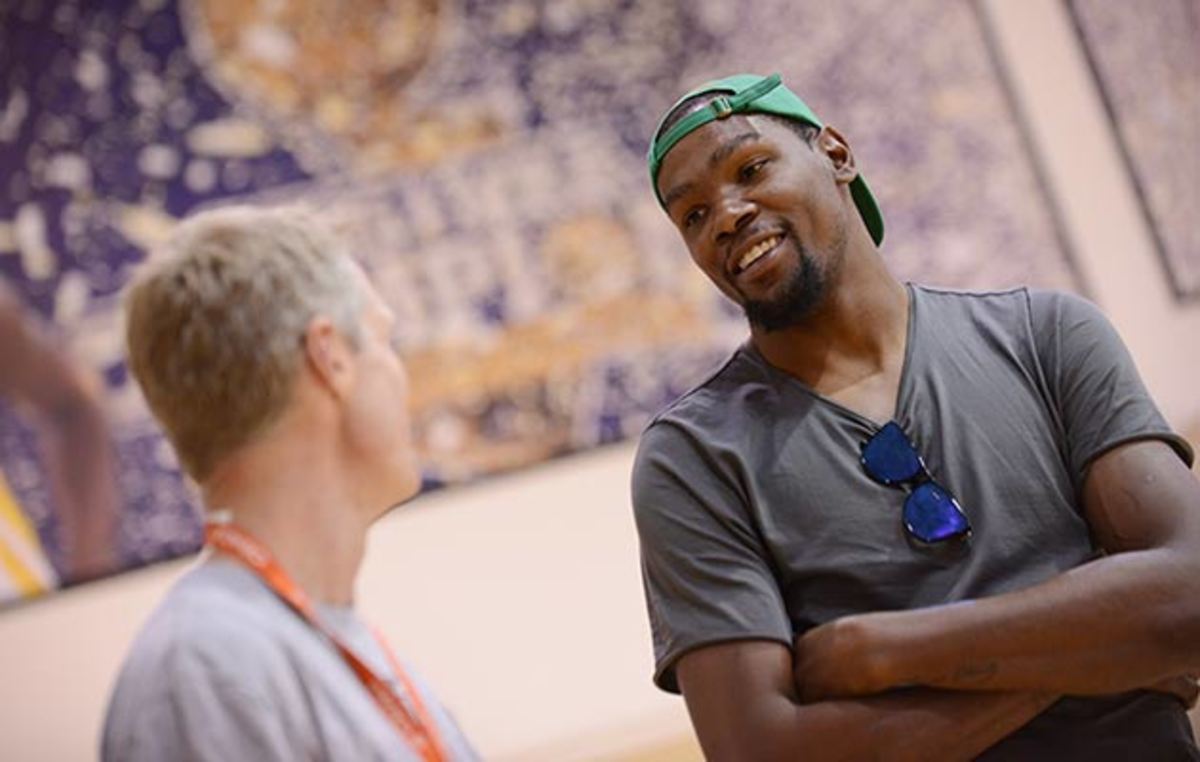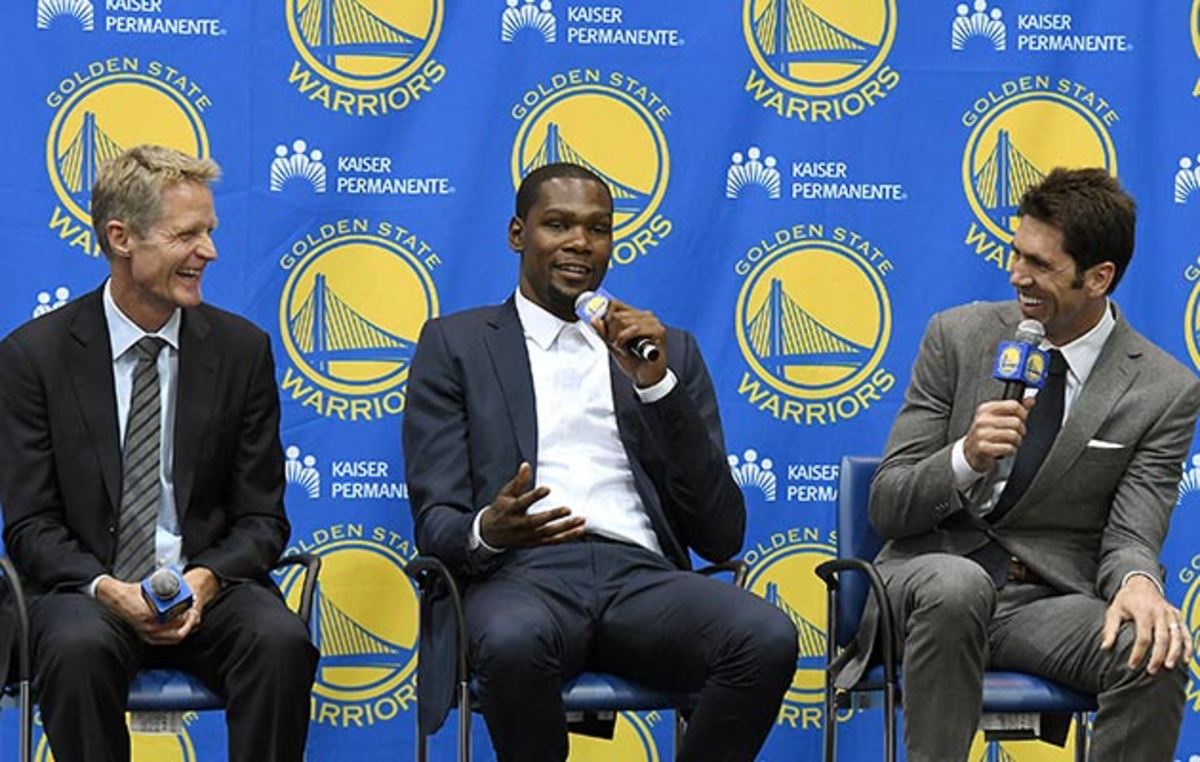The unlikely assist that helped deliver Kevin Durant to the Warriors

Your teams. Your favorite writers. Wherever you want them. Personalize SI with our new App. Install on iOS or Android.
Last fall, the Warriors hired a famous person for an obscure position, tabbing two-time MVP Steve Nash as a player development consultant. The job description was as amorphous as the title suggests. Nash worked out a bit with Klay Thompson. He sent texts to Steph Curry. A few days every month he flew from his home in Los Angeles to Oakland. Occasionally he addressed the team, walking through actions and demonstrating ball screens. But Nash, who retired only a year ago, was not looking for a full-time gig. He is a father of three, the general manager of the Canadian national team and a promising movie producer.
In 2014, when Nash was still a Laker, he agreed to film conversations with other luminaries for a Vice Sports series called “Back & Forth.” In the most notable video, Nash sits on a black leather sofa, wearing a T-shirt and shorts. Next to him, appearing equally casual, is another former MVP: Kevin Durant. With Nash steering the dialogue, they reflect in hushed tones on their roots, motivations and methods. Durant tells Nash that he used to create imaginary basketball games as a boy, using Hot Wheels as players, pennies as balls and tables as courts. They laugh. They connect.
[youtube:https://youtu.be/179T2bfKVJE]
The story of Durant’s departure from Oklahoma City and arrival in Golden State, a move that rocked a league and spawned a superpower, features two iconic point guards. The Warriors believe that Durant, loyal to Russell Westbrook on a personal level, was weary of his ball-dominant approach. Curry presented a free-flowing alternative. But several Golden State coaches and executives also acknowledge the everlasting assist of yet another legendary floor general. “Without Steve Nash,” one says, “I’m not sure if we get Kevin Durant.”
Representatives from six teams passed through the gates of the Hamptons mansion where Durant spent the July 4th weekend. The Warriors presentation wasn’t necessarily more memorable than the others. “We heard the Clippers ‘blew him away,’” says Golden State general manager Bob Myers. “We didn’t blow him away.” Durant was most struck by the body language of the four players in the room—Curry, Thompson, Draymond Green and Andre Iguodala—their effortless conversation and easy laughter. He remarked that they looked as if they were holding hands, even though they were not actually touching. Durant had heard all the breathless accounts of the Dubs’ renowned esprit de corps. He wondered whether their kinship was real, and if it was, whether there was space for another in that cocoon. Those were the questions that nagged at him after the gang left.
• Kevin Durant to the Warriors might be NBA's most fascinating move ever
The Warriors did not lure Durant at the meeting, but in the 48 hours that followed. They are a collaborative organization—remember Nick U’Ren, the lower-level staffer who suggested the lineup change that helped capture the 2015 championship; and Chris DeMarco, the player development coach who recommended switching sides of the court in Game 6 of this year’s Western Conference finals—so it should come as no surprise that free agency was also a group effort with contributions from unlikely sources. Warriors’ advisor Jerry West made headlines with a phone call, but Durant shared more fundamental concerns about chemistry and fit in conversations with Nash.
“Steve knows us—our culture and our guys—so well,” says Golden State assistant coach Bruce Fraser, who was with Nash in Phoenix, as were several other Warriors staffers. “He doesn’t sell anybody on anything. He’s just a great sounding board.” Fraser was also crucial, because he is close to Nash and spoke with him throughout the process. The Warriors were therefore able to understand Durant’s concerns and address them. Even though Myers did not call or text Durant directly, he deployed others, including head coach Steve Kerr. “It’s orchestrating from a distance,” Myers says. “‘Steve, ask if he has any questions. Steph, give him a call so he’s more comfortable. Andre, he might want to hear from you.’ I encouraged all of them. I’m sure other teams did the same thing. But we wanted to feel like, if he said no, it wasn’t because we didn’t show him who we were.”
•Open Floor Podcast: Debating Kevin Durant's decision to join the Warriors
Executives who saw Durant over the weekend, in the mansion off the beach, say he looked drained. He was sitting through as many as six hours of meetings per day, while simultaneously hearing from the Warriors, whose pitch never really ended. Iguodala told Durant he’d have the time of his life in Golden State. Curry insisted he’d be embraced immediately. The Warriors’ incumbent star swore he didn’t care about billboards or shoe sales. He just wanted banners. Durant, already seduced by the Dubs’ rollicking offensive system, was sold. When nine Thunder officials visited Durant on Sunday afternoon, hoping for the last word, they realized they were too late. Durant woke up July 4 at 7 a.m. with his decision made. Informing Oklahoma City general manager Sam Presti, Durant said, was the hardest thing he’s ever done. Calling Myers was even a struggle. “I just want to say you guys are a great first-class organization,” he told the Warriors GM. “It was great getting to know you….but.”
Myers was expecting the qualifier. He had prepared a concession speech, thanking Durant for his consideration, wishing him well in Oklahoma City. “But I just want to tell you I’m coming to the Warriors,” Durant continued. He wasn’t purposefully messing with Myers. He was rattled and fried. When word of his announcement reached Kerr, on vacation in Hawaii, the sun wasn’t up yet over the islands. “We got him! We got him!” hollered Kerr’s wife, Margot, turning over in bed and waking him with jabs to the leg.

There was euphoria in Golden State and agony in Oklahoma City, same as six weeks before, in the wake of the West finals. But the pain was more acute this time and will take longer to subside. Before every game last season, Thunder head coach Billy Donovan slipped into Durant’s locker a hand-written note. Sometimes it was about leadership. Sometimes it was about defense. Sometimes it was just about the upcoming matchup. It was a simple gesture, one of many, underlining OKC’s dedication to Durant. Yes, Westbrook pounds the ball more than Curry, but Westbrook is still one of the three best point guards alive. Yes, Golden State’s attack is more fluid than Oklahoma City’s, but the Thunder still put up the second highest offensive rating of any team in the past five years. If they cannot retain a marquee free agent, after coming up five minutes short of the Finals, what small market can?
• Heartbreak in Oklahoma City: KD says goodbye to city he helped shape
The NBA will have to answer that question, same as in 2010, when the Heat assembled their Big Three and prompted a lockout the following year. The Thunder, meanwhile, must gauge whether they can realistically re-sign Westbrook next summer or if they have to trade him. They can’t lose another superstar for squat. And the Warriors, the lone winners in all this, get to slide the league’s most dynamic scorer next to the two most feared shooters. In the Hamptons, Kerr called up about 15 Warriors plays on his laptop and projected them onto a big-screen TV, showing Durant how he could contribute. “I’ve got some bad habits,” KD said. “That’s okay,” Kerr replied. “I’ll yell at you.”
Westbrook wasn’t the only iso-heavy star in Oklahoma City; Durant also liked to hold the ball. But the Warriors are enamored with the potential of his playmaking ability. They envision running offense through him at the elbow and in the post, where he can kick to shooters and cutters if the defense collapses, or rise and fire if it doesn’t. With Curry and Thompson spreading the court, Durant will enjoy massive swaths of space, and he may never see a double team again. “It should be seamless,” Kerr said. The Warriors don’t have a rim-protecting center, or many qualified reserves, having discarded a chunk of their rotation to make room for Durant. But those are Dom Perignon problems. The Big Four, plus a stiff in marketing, could probably win 50.

The first day, though, was not easy. At his introductory press conference, Durant sat stiffly atop the dais, bracing for the inevitable queries about shortcuts to titles. When Kerr suggested he might bring his shiny new acquisition off the bench, everybody laughed except Durant, causing the coach to clarify. “I’m joking,” he said. Eventually, Durant warmed up. “We live in this superhero comic book world,” he said, “where you’re either a villain or you’re a superhero…I trusted my gut. I trusted my instincts. It’s the unpopular decision. But I can live with it.” From the Philippines, where Canada participated in an Olympic qualifying tournament, Nash downplayed his friend’s quest for NBA gold. “I think it was as much a personal move for his happiness and development as it was to win,” Nash told reporters.
Late Thursday, after a week of advice, introspection and upheaval, Durant went looking for a little of the joy the Warriors talk so much about. There was only one place to go. He wrapped up his press conference and walked onto the practice court. Far from the meetings and the mansion, he grabbed a ball and took a shot.
